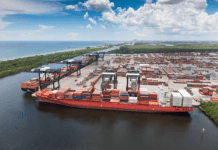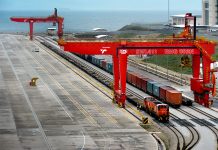
The automated guided vehicle (AGV) fleet at Hamburger Hafen und Logistik AG’s (HHLA) Container Terminal Altenwerder (CTA) in Hamburg is now totally battery-powered.
German port and terminal operator HHLA has taken another step in progressively replacing vehicles that operate on fossil fuels with battery-powered alternatives.
CTA will decommission the final diesel-powered container transporter (automated guided vehicle – AGV) in the fourth quarter of 2023. The new AGV fleet will now consist of 95 battery-powered vehicles that run on renewable electricity.
This implies that no fossil energy is required at any level of the container transit operation, from ship to container storage system – it is now completely electrified.
CTA saves around three million litres of diesel each year by converting to battery-powered AGVs and the corresponding considerable decrease in diesel use, which is equivalent to approximately 8,000 tons of CO2 emissions.
TÜV NORD certified CTA as a climate-neutral firm again in August, because the 14 container gantry cranes for seaborne handling, 52 portal cranes in the container block storage facility, and four rail gantry cranes are already powered by green electricity. CTA is now testing the usage of battery-powered tractor units. The total electrification of the tractor unit fleet at CTA is also intended.
CTA’s final procedures that produce CO2 emissions are offset with compensation certificates. HHLA uses these certificates to assist climate-friendly initiatives that meet the highest Gold Standard of Voluntary Emission Reductions (VER).
The goal is to gradually diminish the percentage of compensation. To do this, HHLA prioritises collaboration with partners to build technically new solutions.
CTA’s AGV fleet conversion was funded by the European Regional Development Fund (ERDF) as part of the “Energiewende in Unternehmen” research project. The objective was to reduce CO2 emissions by increasing the use of variable renewable sources and improving energy supply efficiency.
“The now completed switch to battery-powered AGVs at CTA underlines once more the pioneering role of CTA with regard to sustainability, as we avoid thousands of tonnes of CO2 emissions every year thanks to the reduced diesel consumption. We will also continue to invest in the electrification of the equipment of the other HHLA terminals in order to achieve climate-neutral operations across the Group by 2040,” stated Oliver Dux, director of Technology at HHLA.





